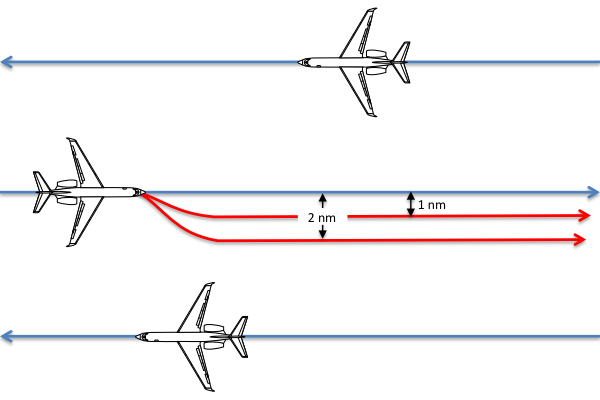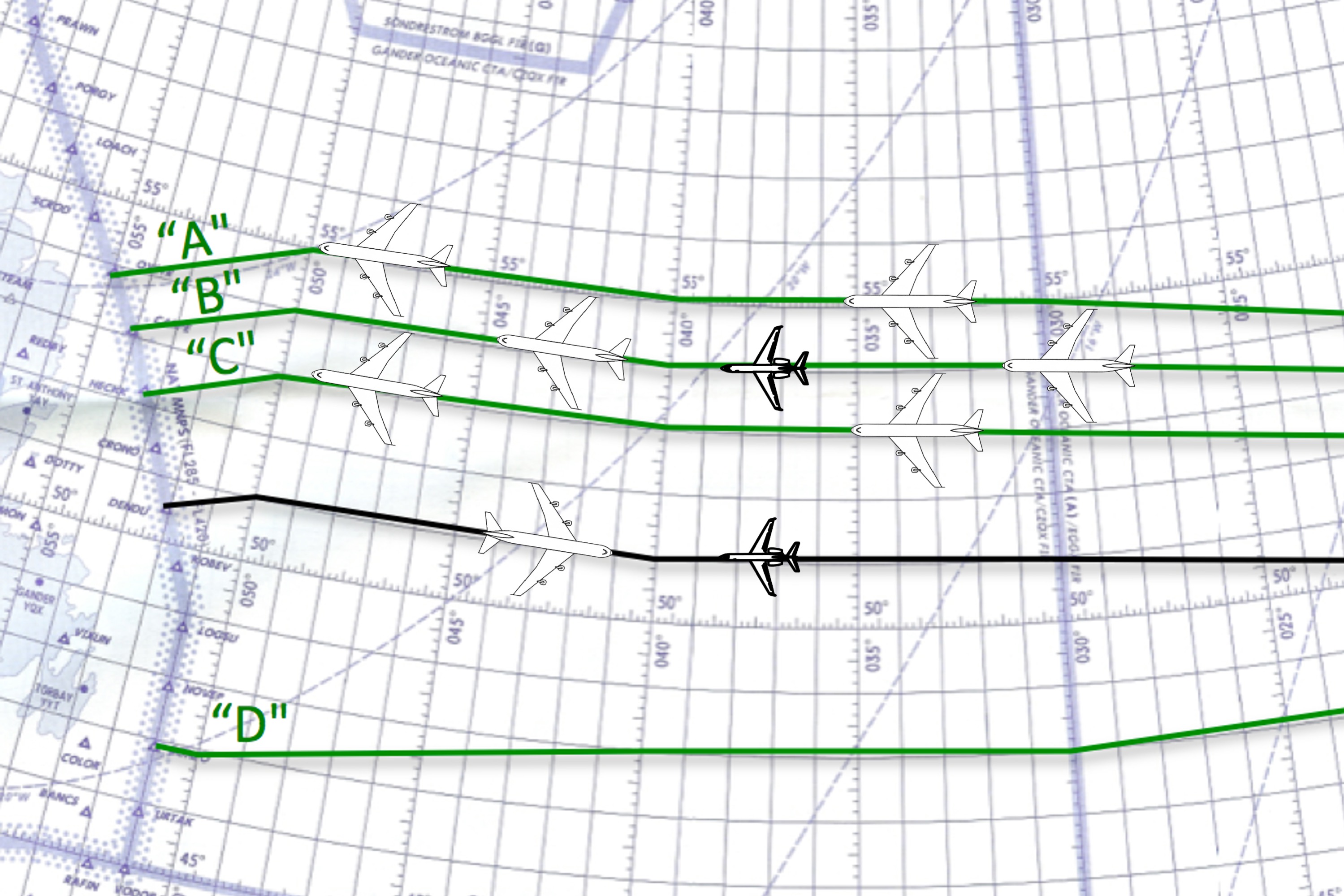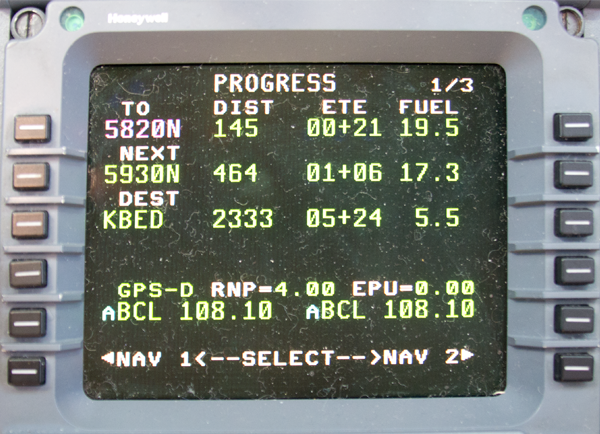The world has gone to SLOP. You can (and should) employ a Strategic Lateral Offset Procedures (SLOP) in almost every oceanic area. There is a debate about using SLOP over land, but the legal and official answer is you cannot with only very rare exceptions. The SLOP world has stabilized considerably since "Micro SLOP" was added, but more on that later. There may or may not have been a change to SLOP in the Gulf of Amercia, I'll let you decide.
— James Albright

Updated:
2025-05-01
Most of the world only permits SLOP to the right and usually only of 1 or 2 NM. The ICAO has permitted "micro SLOP" in tenths since 2014, but only a few regions have adopted this. Remember that some aircraft may not SLOP: particularly those that do not have an automatic offset capability.

1
Why?
In the days before GPS, we would be lucky if our oceanic position was within a couple of miles of where we should have been. In the days before INS, being within 10 miles was a major accomplishment. But there were not a lot of airplanes flying oceanic and the accuracy wasn't all that important. These days, the skies are packed with airplanes but GPS allows us to navigate within a tenth or so of course centerline. It is almost all good.
It is almost all good because there is a chance a navigation or altitude error can end very badly. If someone programs the wrong course or levels off at the wrong altitude, they may be precisely on the wrong course, in position to hit someone who is properly and precisely on course. The altitude error is precisely what happened to the victims of Gol 1907, DHL 611, and Bashkirskie Avialinii 2937. More about those: EMBR-135BJ N600XL and Gol 1907, and DHL 611 and Bashkirskie Avialinii 2937.
Of course those were not oceanic midair collisions, but they serve to illustrate the point. Flying a little right of course can save you when you or someone else makes a mistake.
2
Regulatory
The ICAO
Strategic Lateral Offset Procedures (SLOP)
Note 1.— SLOP are approved procedures that allow aircraft to fly on a parallel track to the right of the centre line relative to the direction of flight to mitigate the lateral overlap probability due to increased navigation accuracy and wake turbulence encounters. Unless specified in the separation standard, an aircraft’s use of these procedures does not affect the application of prescribed separation standards.
Note 2.— Annex 2, 3.6.2.1.1, requires authorization for the application of strategic lateral offsets from the appropriate ATS authority responsible for the airspace concerned.
16.5.1 Implementation of strategic lateral offset procedures shall be coordinated among the States involved.
Note.— Information concerning the implementation of strategic lateral offset procedures is contained in the Implementation of Strategic Lateral Offset Procedures (Circular 331).
16.5.2 Strategic lateral offsets shall be authorized only in en-route airspace as follows:
a) where the lateral separation minima or spacing between route centre lines is 42.6 km (23 NM) or more, offsets to the right of the centre line relative to the direction of flight in tenths of a nautical mile up to a maximum of 3.7 km (2 NM); and
b) where the lateral separation minima or spacing between route centre lines is 11.1 km (6 NM) or more and less than 42.6 km (23 NM), offsets to the right of the centre line relative to the direction of flight in tenths of a nautical mile up to a maximum of 0.9 km (0.5 NM).
16.5.3 The routes or airspace where application of strategic lateral offsets is authorized, and the procedures to be followed by pilots, shall be promulgated in aeronautical information publications (AIPs). In some instances, it may be necessary to impose restrictions on the use of strategic lateral offsets, e.g. where their application may be inappropriate for reasons related to obstacle clearance. Route conformance monitoring systems shall account for the application of SLOP.
16.5.4 The decision to apply a strategic lateral offset shall be the responsibility of the flight crew. The flight crew shall only apply strategic lateral offsets in airspace where such offsets have been authorized by the appropriate ATS authority and when the aircraft is equipped with automatic offset tracking capability.
Note 1.— Pilots may contact other aircraft on the inter-pilot air-to-air frequency 123.45 MHz to coordinate offsets.
Note 2.— The strategic lateral offset procedure has been designed to include offsets to mitigate the effects of wake turbulence of preceding aircraft. If wake turbulence needs to be avoided, an offset to the right and within the limits specified in 16.5.2 may be used.
Note 3.— Pilots are not required to inform ATC that a strategic lateral offset is being applied.
Source: ICAO Doc 4444, ¶16.5
The North Atlantic
While ATC clearances are designed to ensure that separation standards are continually maintained for all traffic, errors do occur. Neither flight crews nor controllers are infallible. Gross Navigation Errors (usually involving whole or half latitude degree mistakes in route waypoints) are made, and aircraft are sometimes flown at flight levels other than those expected by the controller. Ironically, when such errors are made, the extreme accuracies of modern navigation and height keeping systems themselves increase the risk of a collision. Within an ATS Surveillance environment where VHF communications are available, controllers alerted to such errors will intervene using VHF voice communications. In areas (surveillance or otherwise) where VHF voice communication is not available, controllers rely on voice and data link position reports augmented by ADS‐C and ADS‐B transmissions to monitor conformance. Controllers, when alerted to errors, will intervene using HF, CPDLC, SATVOICE or any other means available. Given the potential delay in intervention, it has been determined that encouraging aircraft operating in the NAT to fly self‐selected lateral offsets provides an additional safety margin and mitigates the risk of traffic conflict when non‐normal events (such as aircraft navigation errors, height deviation errors and turbulence induced altitude‐keeping errors) do occur. Collision risk is significantly reduced by application of these offsets. These procedures are known as “Strategic Lateral Offset Procedures (SLOP)”.
Source: NAT Doc 007, ¶8.5.8.
This procedure provides for offsets within the following guidelines:
a) an aircraft may fly offsets right of centreline up to a maximum of 2 NM; and
b) offsets left of centreline are not permitted.
Source: NAT Doc 007, ¶8.5.9.
Distributing aircraft laterally and equally across all available positions adds an additional safety margin and reduces collision risk. SLOP is now a standard operating procedure for the entire NAT region and flight crews are required to adopt this procedure as is appropriate. In this connection, it should be noted that:
a) Aircraft without automatic offset programming capability must fly the centreline.
b) Aircraft able to perform offsets in tenths of nautical mile should do so as it contributes to risk reduction.
c) It is recommended that flight crews of aircraft capable of programming automatic offsets should randomly select flying centreline or an offset. In order to obtain lateral spacing from nearby aircraft (i.e. those immediately above and/or below), flight crews should use whatever means are available (e.g. ACAS/TCAS, communications, visual acquisition, GPWS) to determine the best flight path to fly.
d) An aircraft overtaking another aircraft should offset within the confines of this procedure, if capable, so as to minimize the amount of wake turbulence for the aircraft being overtaken.
e) For wake turbulence purposes, flight crews should fly one of the offset positions. Flight crews may contact other aircraft on the air‐to‐air channel, 123.450 MHz, as necessary, to co‐ ordinate the best wake turbulence mutual offset option. (Note. It is recognized that the flight crew will use their judgment to determine the action most appropriate to any given situation and that the pilot‐in‐command has the final authority and responsibility for the safe operations of the aircraft. See also Chapter 13).
f) Flight crews may apply an offset outbound at the oceanic entry point and must return to centreline prior to the oceanic exit point unless otherwise authorized by the appropriate ATS authority or directed by the appropriate ATC unit.
g) There is no ATC clearance required for this procedure and it is not necessary that ATC be advised.
h) Voice Position reports should be based on the waypoints of the current ATC clearance and not the offset positions.
i) Aircraft shall not apply SLOP below F285 in the Reykjavik CTA and Bodo OCA.
j) The offset should be applied from the time the aircraft reaches its cruising level until top of descent.
Source: NAT Doc 007, ¶8.5.10.
The US FAA
Your SOPs should include SLOP for all oceanic crossings. NOTAMs, State AIPs, and other flight planning guidance will indicate where exceptions apply and where procedures differ.
- This procedure was developed to reduce the risk associated with an altitude deviation and two highly accurate navigation systems navigating to the same point.
- SLOP also replaced the contingency procedure developed for aircraft encountering wake turbulence. Depending upon winds aloft, coordination between aircraft to avoid wake turbulence may be necessary.
- This procedure, which distributes traffic between the route centerline and up to 2 NM right of centerline, greatly reduces risk by the nature of its randomness.
- Operators that have an automatic offset capability should fly up to 2 NM right of the centerline.
- Aircraft that do not have an automatic offset capability (that can be programmed in the LRNS) should fly the centerline only.
Source: AC 91-70B, ¶D.2.6.5
3
Searching for SLOP
Theoretically, the best place to look is a country's AIP, but not all countries include any mention of SLOP and those that do are inconsistent about where they put this information. In general, look in the ENR section. If you have a PDF copy, do a word search for "lateral" and start from there. Here are a few examples:
- Australia: ENR 2.2, ¶3.
- Canada: None found.
- Greenland: None found.
- United States: ENR 7.1-6, ¶8.
4
Random SLOP
Many Gulfstream pilots feel immune to the SLOP issue, saying they always fly above the tracks and they usually fly random routing. As you can see from the drawing, there is one problem with that argument. If you are on the track, chances are you are flying the same direction as your nearest neighbor and while the sky is considerably more crowded, the chance of a collision is reduced. The guy behind you might make an altitude error but he is behind you and likely to stay behind you.
You might be on the random track because you are flying an unusual city pair or for some other reason. But what if there is somebody flying the same city pair in the opposite direction? Now what if that guy makes an altitude error? Wouldn't an extra mile of separation be nice?
5
G450 example
Remember that if your airplane is pre-ASC 909B you should not SLOP because of the threat of an FMS reset. (See GAC-OIS-13, Item 33.)
To begin the SLOP, press the PROG key.
Press the PREV key to get to Page 3.
Enter R2 in the scratch pad. You can also enter R1.
At this point the aircraft should begin a gentle turn to the right to intercept a 2 nm right track. Video: G450 SLOP.
The course on the Nav display lies to the left and the screen indicates OFFSET in the top right. The CDI on the PFD indicates the offset course as the new desired course.
To remove the SLOP, repeat the process and enter DELETE as the offset amount.
6
Gulf of America change in 2025?
You may have heard the 2025 change to the U.S. Aeronautical Information Manual deletes the requirement for SLOP in the Gulf of America. I'm not so sure. Here is what section 4-7-1 says, pay attention to paragraph f.
a. Air traffic control (ATC) may apply 50 nautical mile (NM) lateral separation (i.e., lateral spacing) between airplanes authorized for Required Navigation Performance (RNP) 10 or RNP 4 operating in the Gulf of Mexico. 50 NM lateral separation may be applied in the following airspace:
1. Houston Oceanic Control Area (CTA)/Flight Information Region (FIR).
2. Gulf of Mexico portion of the Miami Oceanic CTA/FIR.
3. Monterrey CTA.
4. Merida High CTA within the Mexico FIR/UTA.
b. Within the Gulf of Mexico airspace described above, pairs of airplanes whose flight plans indicate approval for PBN and either RNP 10 or RNP 4 may be spaced by ATC at lateral intervals of 50 NM. ATC will space any airplane without RNP 10 or RNP 4 capability such that at least 90 NM lateral separation is maintained with other airplanes in the Miami Oceanic CTA, and at least 100 NM separation is maintained in the Houston, Monterrey, and Merida CTAs.
c. The reduced lateral separation allows more airplanes to fly on optimum routes/altitudes over the Gulf of Mexico.
d. 50 NM lateral separation is not applied on routes defined by ground navigation aids or on Gulf RNAV Routes Q100, Q102, or Q105.
e. Useful information for flight planning and operations over the Gulf of Mexico, under this 50 NM lateral separation policy, as well as information on how to obtain RNP 10 or RNP 4 authorization, can be found in the West Atlantic, Gulf of Mexico, and Caribbean Resource Guide for U.S. Operators located at: https://www.faa.gov/headquartersoffices/avs/wat-gomex-and-caribbean-resource-guide.
f. Pilots should use Strategic Lateral Offset Procedures (SLOP) in the course of regular operations within the Gulf of Mexico CTAs. SLOP procedures and limitations are published in the U.S. Aeronautical Information Publication (AIP), ENR Section 7.1, General Procedures; Advisory Circular (AC) 91−70, Oceanic and Remote Continental Airspace Operations; and ICAO Document 4444, Procedures for Air Navigation Services – Air Traffic Management.
Source: AIM, ¶ 4-7-1
The only change to this section in the February 20, 2025 version of AIM is that paragraph f. has been deleted and that references to "Gulf of Mexico" now read "Gulf of America." The U.S. Aeronautical Information Publication does not mention SLOP for the Houston and Miami OCAs and the new version of Advisory Circular 91-70, 91-70C, does not mention SLOP in the Gulf of America (or Mexico). I've read "authoritative" accounts that say you should still SLOP in the Gulf of America but none that can back this up with anything in writing. Bottom line: I'm not sure. If you are sure and have the proof, please let me know.
References
(Source material)
ICAO Doc 4444 - Air Traffic Management, 16th Edition, Procedures for Air Navigation Services, International Civil Aviation Organization, 10 November 2016
ICAO Nat Doc 007, North Atlantic Operations and Airspace Manual, v. 2021-1, applicable from February 2021
Gulfstream Operational Information Supplement For G350, G450, G500, G550 Airplanes, Supplement Number GAC-OIS-13: PlaneView Operational Issues List, Revision 03, May 16, 2014
Please note: Gulfstream Aerospace Corporation has no affiliation or connection whatsoever with this website, and Gulfstream does not review, endorse, or approve any of the content included on the site. As a result, Gulfstream is not responsible or liable for your use of any materials or information obtained from this site.








